Causes of Sciatica in Pregnancy
VerifiedAdded on 2023/01/20
|8
|3044
|36
AI Summary
This article discusses the various reasons why sciatica can develop in pregnant women, including weight gain, fluid retention, changes in center of gravity, and pressure from the growing fetus. It also explains how hormonal changes during pregnancy can contribute to sciatica. Find more information on Desklib.
Contribute Materials
Your contribution can guide someone’s learning journey. Share your
documents today.
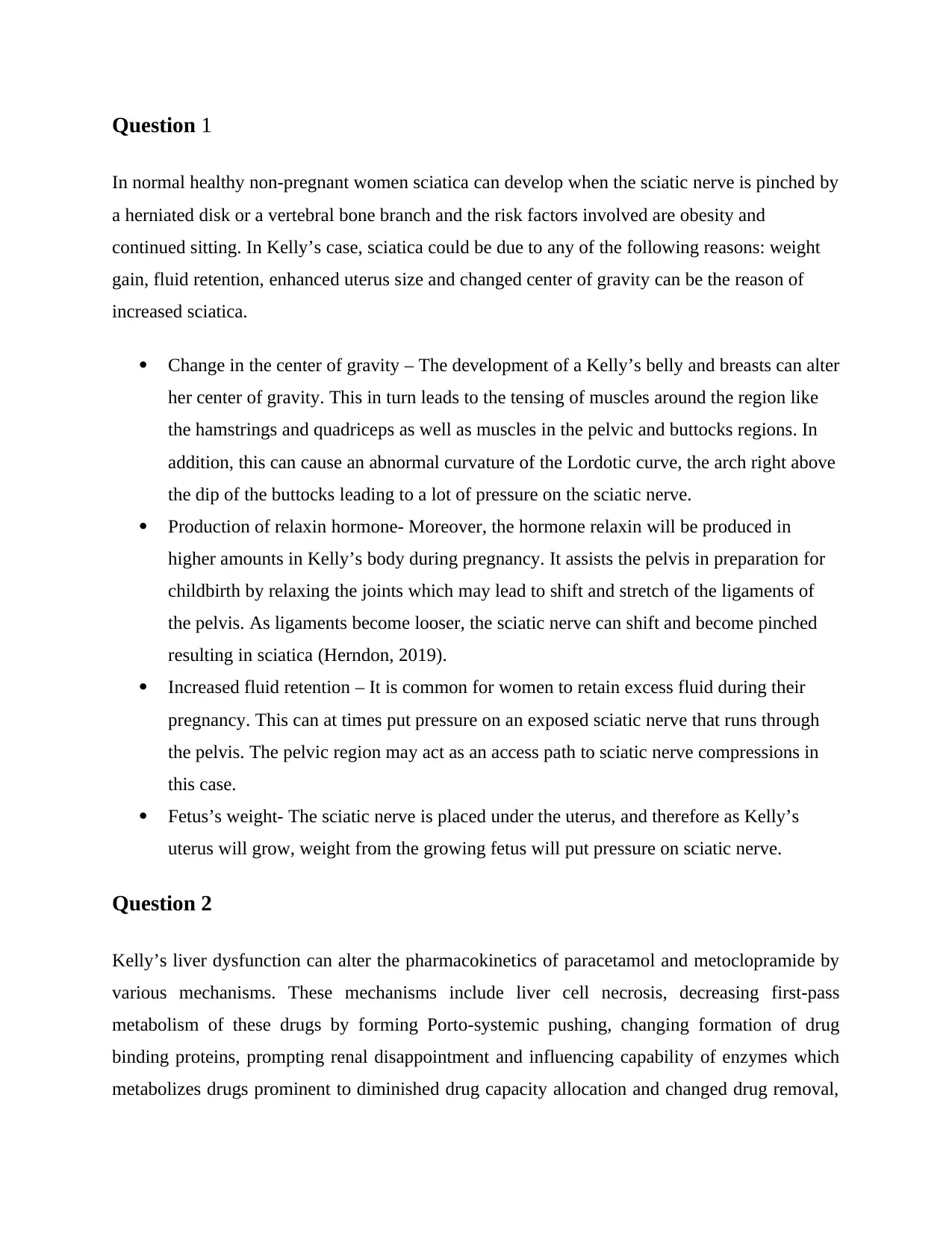
Question 1
In normal healthy non-pregnant women sciatica can develop when the sciatic nerve is pinched by
a herniated disk or a vertebral bone branch and the risk factors involved are obesity and
continued sitting. In Kelly’s case, sciatica could be due to any of the following reasons: weight
gain, fluid retention, enhanced uterus size and changed center of gravity can be the reason of
increased sciatica.
Change in the center of gravity – The development of a Kelly’s belly and breasts can alter
her center of gravity. This in turn leads to the tensing of muscles around the region like
the hamstrings and quadriceps as well as muscles in the pelvic and buttocks regions. In
addition, this can cause an abnormal curvature of the Lordotic curve, the arch right above
the dip of the buttocks leading to a lot of pressure on the sciatic nerve.
Production of relaxin hormone- Moreover, the hormone relaxin will be produced in
higher amounts in Kelly’s body during pregnancy. It assists the pelvis in preparation for
childbirth by relaxing the joints which may lead to shift and stretch of the ligaments of
the pelvis. As ligaments become looser, the sciatic nerve can shift and become pinched
resulting in sciatica (Herndon, 2019).
Increased fluid retention – It is common for women to retain excess fluid during their
pregnancy. This can at times put pressure on an exposed sciatic nerve that runs through
the pelvis. The pelvic region may act as an access path to sciatic nerve compressions in
this case.
Fetus’s weight- The sciatic nerve is placed under the uterus, and therefore as Kelly’s
uterus will grow, weight from the growing fetus will put pressure on sciatic nerve.
Question 2
Kelly’s liver dysfunction can alter the pharmacokinetics of paracetamol and metoclopramide by
various mechanisms. These mechanisms include liver cell necrosis, decreasing first-pass
metabolism of these drugs by forming Porto-systemic pushing, changing formation of drug
binding proteins, prompting renal disappointment and influencing capability of enzymes which
metabolizes drugs prominent to diminished drug capacity allocation and changed drug removal,
In normal healthy non-pregnant women sciatica can develop when the sciatic nerve is pinched by
a herniated disk or a vertebral bone branch and the risk factors involved are obesity and
continued sitting. In Kelly’s case, sciatica could be due to any of the following reasons: weight
gain, fluid retention, enhanced uterus size and changed center of gravity can be the reason of
increased sciatica.
Change in the center of gravity – The development of a Kelly’s belly and breasts can alter
her center of gravity. This in turn leads to the tensing of muscles around the region like
the hamstrings and quadriceps as well as muscles in the pelvic and buttocks regions. In
addition, this can cause an abnormal curvature of the Lordotic curve, the arch right above
the dip of the buttocks leading to a lot of pressure on the sciatic nerve.
Production of relaxin hormone- Moreover, the hormone relaxin will be produced in
higher amounts in Kelly’s body during pregnancy. It assists the pelvis in preparation for
childbirth by relaxing the joints which may lead to shift and stretch of the ligaments of
the pelvis. As ligaments become looser, the sciatic nerve can shift and become pinched
resulting in sciatica (Herndon, 2019).
Increased fluid retention – It is common for women to retain excess fluid during their
pregnancy. This can at times put pressure on an exposed sciatic nerve that runs through
the pelvis. The pelvic region may act as an access path to sciatic nerve compressions in
this case.
Fetus’s weight- The sciatic nerve is placed under the uterus, and therefore as Kelly’s
uterus will grow, weight from the growing fetus will put pressure on sciatic nerve.
Question 2
Kelly’s liver dysfunction can alter the pharmacokinetics of paracetamol and metoclopramide by
various mechanisms. These mechanisms include liver cell necrosis, decreasing first-pass
metabolism of these drugs by forming Porto-systemic pushing, changing formation of drug
binding proteins, prompting renal disappointment and influencing capability of enzymes which
metabolizes drugs prominent to diminished drug capacity allocation and changed drug removal,
Secure Best Marks with AI Grader
Need help grading? Try our AI Grader for instant feedback on your assignments.
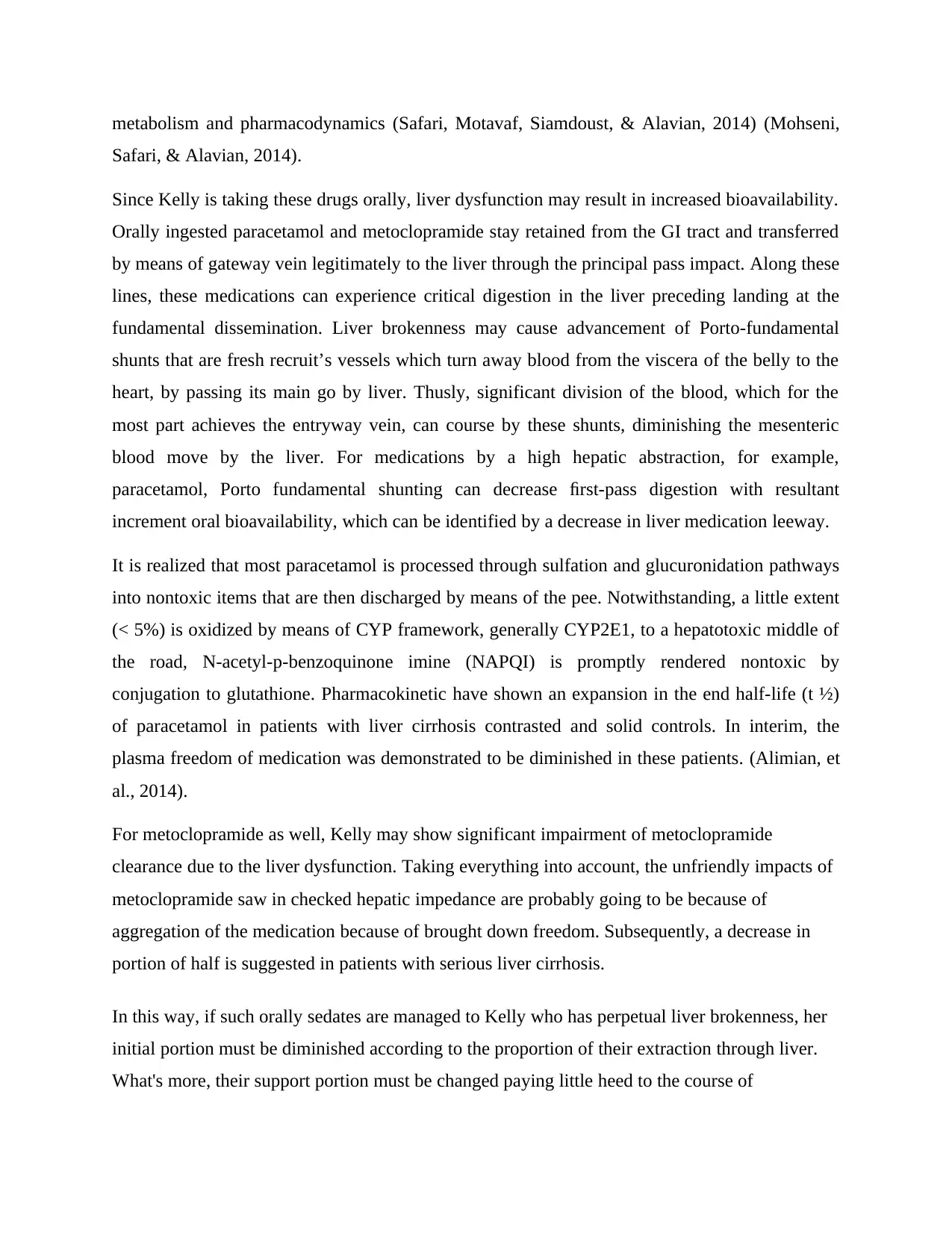
metabolism and pharmacodynamics (Safari, Motavaf, Siamdoust, & Alavian, 2014) (Mohseni,
Safari, & Alavian, 2014).
Since Kelly is taking these drugs orally, liver dysfunction may result in increased bioavailability.
Orally ingested paracetamol and metoclopramide stay retained from the GI tract and transferred
by means of gateway vein legitimately to the liver through the principal pass impact. Along these
lines, these medications can experience critical digestion in the liver preceding landing at the
fundamental dissemination. Liver brokenness may cause advancement of Porto-fundamental
shunts that are fresh recruit’s vessels which turn away blood from the viscera of the belly to the
heart, by passing its main go by liver. Thusly, significant division of the blood, which for the
most part achieves the entryway vein, can course by these shunts, diminishing the mesenteric
blood move by the liver. For medications by a high hepatic abstraction, for example,
paracetamol, Porto fundamental shunting can decrease first-pass digestion with resultant
increment oral bioavailability, which can be identified by a decrease in liver medication leeway.
It is realized that most paracetamol is processed through sulfation and glucuronidation pathways
into nontoxic items that are then discharged by means of the pee. Notwithstanding, a little extent
(< 5%) is oxidized by means of CYP framework, generally CYP2E1, to a hepatotoxic middle of
the road, N-acetyl-p-benzoquinone imine (NAPQI) is promptly rendered nontoxic by
conjugation to glutathione. Pharmacokinetic have shown an expansion in the end half-life (t ½)
of paracetamol in patients with liver cirrhosis contrasted and solid controls. In interim, the
plasma freedom of medication was demonstrated to be diminished in these patients. (Alimian, et
al., 2014).
For metoclopramide as well, Kelly may show significant impairment of metoclopramide
clearance due to the liver dysfunction. Taking everything into account, the unfriendly impacts of
metoclopramide saw in checked hepatic impedance are probably going to be because of
aggregation of the medication because of brought down freedom. Subsequently, a decrease in
portion of half is suggested in patients with serious liver cirrhosis.
In this way, if such orally sedates are managed to Kelly who has perpetual liver brokenness, her
initial portion must be diminished according to the proportion of their extraction through liver.
What's more, their support portion must be changed paying little heed to the course of
Safari, & Alavian, 2014).
Since Kelly is taking these drugs orally, liver dysfunction may result in increased bioavailability.
Orally ingested paracetamol and metoclopramide stay retained from the GI tract and transferred
by means of gateway vein legitimately to the liver through the principal pass impact. Along these
lines, these medications can experience critical digestion in the liver preceding landing at the
fundamental dissemination. Liver brokenness may cause advancement of Porto-fundamental
shunts that are fresh recruit’s vessels which turn away blood from the viscera of the belly to the
heart, by passing its main go by liver. Thusly, significant division of the blood, which for the
most part achieves the entryway vein, can course by these shunts, diminishing the mesenteric
blood move by the liver. For medications by a high hepatic abstraction, for example,
paracetamol, Porto fundamental shunting can decrease first-pass digestion with resultant
increment oral bioavailability, which can be identified by a decrease in liver medication leeway.
It is realized that most paracetamol is processed through sulfation and glucuronidation pathways
into nontoxic items that are then discharged by means of the pee. Notwithstanding, a little extent
(< 5%) is oxidized by means of CYP framework, generally CYP2E1, to a hepatotoxic middle of
the road, N-acetyl-p-benzoquinone imine (NAPQI) is promptly rendered nontoxic by
conjugation to glutathione. Pharmacokinetic have shown an expansion in the end half-life (t ½)
of paracetamol in patients with liver cirrhosis contrasted and solid controls. In interim, the
plasma freedom of medication was demonstrated to be diminished in these patients. (Alimian, et
al., 2014).
For metoclopramide as well, Kelly may show significant impairment of metoclopramide
clearance due to the liver dysfunction. Taking everything into account, the unfriendly impacts of
metoclopramide saw in checked hepatic impedance are probably going to be because of
aggregation of the medication because of brought down freedom. Subsequently, a decrease in
portion of half is suggested in patients with serious liver cirrhosis.
In this way, if such orally sedates are managed to Kelly who has perpetual liver brokenness, her
initial portion must be diminished according to the proportion of their extraction through liver.
What's more, their support portion must be changed paying little heed to the course of
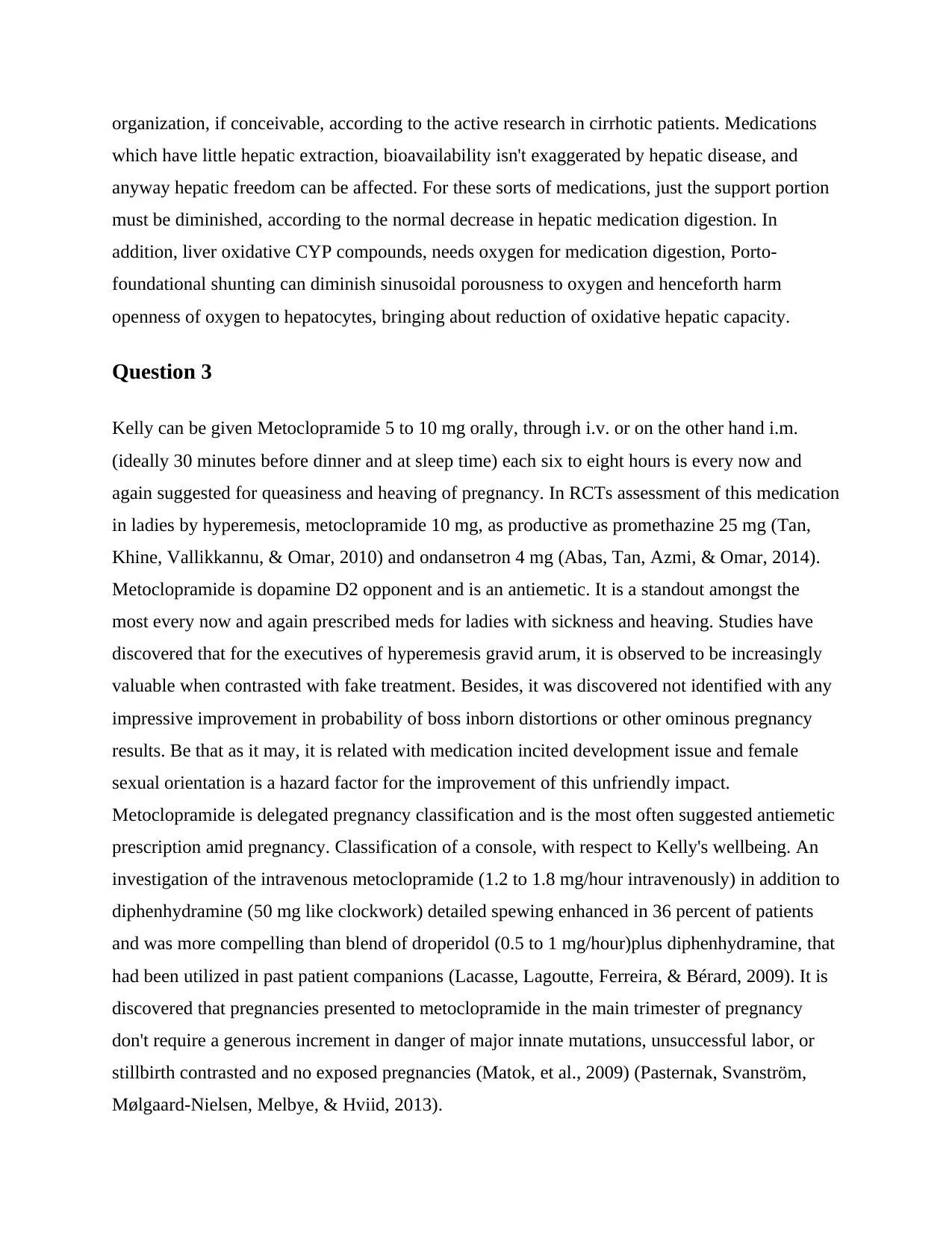
organization, if conceivable, according to the active research in cirrhotic patients. Medications
which have little hepatic extraction, bioavailability isn't exaggerated by hepatic disease, and
anyway hepatic freedom can be affected. For these sorts of medications, just the support portion
must be diminished, according to the normal decrease in hepatic medication digestion. In
addition, liver oxidative CYP compounds, needs oxygen for medication digestion, Porto-
foundational shunting can diminish sinusoidal porousness to oxygen and henceforth harm
openness of oxygen to hepatocytes, bringing about reduction of oxidative hepatic capacity.
Question 3
Kelly can be given Metoclopramide 5 to 10 mg orally, through i.v. or on the other hand i.m.
(ideally 30 minutes before dinner and at sleep time) each six to eight hours is every now and
again suggested for queasiness and heaving of pregnancy. In RCTs assessment of this medication
in ladies by hyperemesis, metoclopramide 10 mg, as productive as promethazine 25 mg (Tan,
Khine, Vallikkannu, & Omar, 2010) and ondansetron 4 mg (Abas, Tan, Azmi, & Omar, 2014).
Metoclopramide is dopamine D2 opponent and is an antiemetic. It is a standout amongst the
most every now and again prescribed meds for ladies with sickness and heaving. Studies have
discovered that for the executives of hyperemesis gravid arum, it is observed to be increasingly
valuable when contrasted with fake treatment. Besides, it was discovered not identified with any
impressive improvement in probability of boss inborn distortions or other ominous pregnancy
results. Be that as it may, it is related with medication incited development issue and female
sexual orientation is a hazard factor for the improvement of this unfriendly impact.
Metoclopramide is delegated pregnancy classification and is the most often suggested antiemetic
prescription amid pregnancy. Classification of a console, with respect to Kelly's wellbeing. An
investigation of the intravenous metoclopramide (1.2 to 1.8 mg/hour intravenously) in addition to
diphenhydramine (50 mg like clockwork) detailed spewing enhanced in 36 percent of patients
and was more compelling than blend of droperidol (0.5 to 1 mg/hour)plus diphenhydramine, that
had been utilized in past patient companions (Lacasse, Lagoutte, Ferreira, & Bérard, 2009). It is
discovered that pregnancies presented to metoclopramide in the main trimester of pregnancy
don't require a generous increment in danger of major innate mutations, unsuccessful labor, or
stillbirth contrasted and no exposed pregnancies (Matok, et al., 2009) (Pasternak, Svanström,
Mølgaard-Nielsen, Melbye, & Hviid, 2013).
which have little hepatic extraction, bioavailability isn't exaggerated by hepatic disease, and
anyway hepatic freedom can be affected. For these sorts of medications, just the support portion
must be diminished, according to the normal decrease in hepatic medication digestion. In
addition, liver oxidative CYP compounds, needs oxygen for medication digestion, Porto-
foundational shunting can diminish sinusoidal porousness to oxygen and henceforth harm
openness of oxygen to hepatocytes, bringing about reduction of oxidative hepatic capacity.
Question 3
Kelly can be given Metoclopramide 5 to 10 mg orally, through i.v. or on the other hand i.m.
(ideally 30 minutes before dinner and at sleep time) each six to eight hours is every now and
again suggested for queasiness and heaving of pregnancy. In RCTs assessment of this medication
in ladies by hyperemesis, metoclopramide 10 mg, as productive as promethazine 25 mg (Tan,
Khine, Vallikkannu, & Omar, 2010) and ondansetron 4 mg (Abas, Tan, Azmi, & Omar, 2014).
Metoclopramide is dopamine D2 opponent and is an antiemetic. It is a standout amongst the
most every now and again prescribed meds for ladies with sickness and heaving. Studies have
discovered that for the executives of hyperemesis gravid arum, it is observed to be increasingly
valuable when contrasted with fake treatment. Besides, it was discovered not identified with any
impressive improvement in probability of boss inborn distortions or other ominous pregnancy
results. Be that as it may, it is related with medication incited development issue and female
sexual orientation is a hazard factor for the improvement of this unfriendly impact.
Metoclopramide is delegated pregnancy classification and is the most often suggested antiemetic
prescription amid pregnancy. Classification of a console, with respect to Kelly's wellbeing. An
investigation of the intravenous metoclopramide (1.2 to 1.8 mg/hour intravenously) in addition to
diphenhydramine (50 mg like clockwork) detailed spewing enhanced in 36 percent of patients
and was more compelling than blend of droperidol (0.5 to 1 mg/hour)plus diphenhydramine, that
had been utilized in past patient companions (Lacasse, Lagoutte, Ferreira, & Bérard, 2009). It is
discovered that pregnancies presented to metoclopramide in the main trimester of pregnancy
don't require a generous increment in danger of major innate mutations, unsuccessful labor, or
stillbirth contrasted and no exposed pregnancies (Matok, et al., 2009) (Pasternak, Svanström,
Mølgaard-Nielsen, Melbye, & Hviid, 2013).
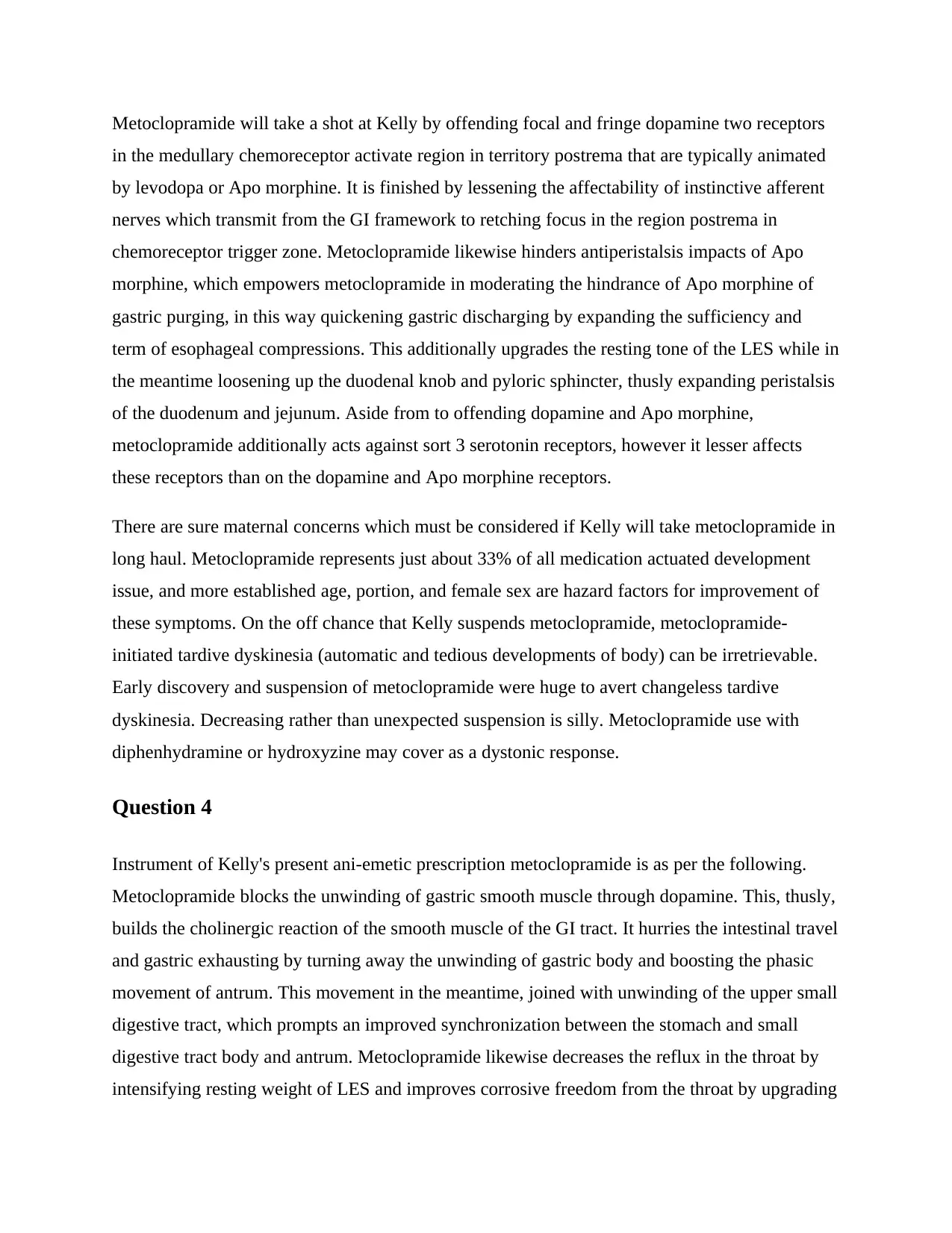
Metoclopramide will take a shot at Kelly by offending focal and fringe dopamine two receptors
in the medullary chemoreceptor activate region in territory postrema that are typically animated
by levodopa or Apo morphine. It is finished by lessening the affectability of instinctive afferent
nerves which transmit from the GI framework to retching focus in the region postrema in
chemoreceptor trigger zone. Metoclopramide likewise hinders antiperistalsis impacts of Apo
morphine, which empowers metoclopramide in moderating the hindrance of Apo morphine of
gastric purging, in this way quickening gastric discharging by expanding the sufficiency and
term of esophageal compressions. This additionally upgrades the resting tone of the LES while in
the meantime loosening up the duodenal knob and pyloric sphincter, thusly expanding peristalsis
of the duodenum and jejunum. Aside from to offending dopamine and Apo morphine,
metoclopramide additionally acts against sort 3 serotonin receptors, however it lesser affects
these receptors than on the dopamine and Apo morphine receptors.
There are sure maternal concerns which must be considered if Kelly will take metoclopramide in
long haul. Metoclopramide represents just about 33% of all medication actuated development
issue, and more established age, portion, and female sex are hazard factors for improvement of
these symptoms. On the off chance that Kelly suspends metoclopramide, metoclopramide-
initiated tardive dyskinesia (automatic and tedious developments of body) can be irretrievable.
Early discovery and suspension of metoclopramide were huge to avert changeless tardive
dyskinesia. Decreasing rather than unexpected suspension is silly. Metoclopramide use with
diphenhydramine or hydroxyzine may cover as a dystonic response.
Question 4
Instrument of Kelly's present ani-emetic prescription metoclopramide is as per the following.
Metoclopramide blocks the unwinding of gastric smooth muscle through dopamine. This, thusly,
builds the cholinergic reaction of the smooth muscle of the GI tract. It hurries the intestinal travel
and gastric exhausting by turning away the unwinding of gastric body and boosting the phasic
movement of antrum. This movement in the meantime, joined with unwinding of the upper small
digestive tract, which prompts an improved synchronization between the stomach and small
digestive tract body and antrum. Metoclopramide likewise decreases the reflux in the throat by
intensifying resting weight of LES and improves corrosive freedom from the throat by upgrading
in the medullary chemoreceptor activate region in territory postrema that are typically animated
by levodopa or Apo morphine. It is finished by lessening the affectability of instinctive afferent
nerves which transmit from the GI framework to retching focus in the region postrema in
chemoreceptor trigger zone. Metoclopramide likewise hinders antiperistalsis impacts of Apo
morphine, which empowers metoclopramide in moderating the hindrance of Apo morphine of
gastric purging, in this way quickening gastric discharging by expanding the sufficiency and
term of esophageal compressions. This additionally upgrades the resting tone of the LES while in
the meantime loosening up the duodenal knob and pyloric sphincter, thusly expanding peristalsis
of the duodenum and jejunum. Aside from to offending dopamine and Apo morphine,
metoclopramide additionally acts against sort 3 serotonin receptors, however it lesser affects
these receptors than on the dopamine and Apo morphine receptors.
There are sure maternal concerns which must be considered if Kelly will take metoclopramide in
long haul. Metoclopramide represents just about 33% of all medication actuated development
issue, and more established age, portion, and female sex are hazard factors for improvement of
these symptoms. On the off chance that Kelly suspends metoclopramide, metoclopramide-
initiated tardive dyskinesia (automatic and tedious developments of body) can be irretrievable.
Early discovery and suspension of metoclopramide were huge to avert changeless tardive
dyskinesia. Decreasing rather than unexpected suspension is silly. Metoclopramide use with
diphenhydramine or hydroxyzine may cover as a dystonic response.
Question 4
Instrument of Kelly's present ani-emetic prescription metoclopramide is as per the following.
Metoclopramide blocks the unwinding of gastric smooth muscle through dopamine. This, thusly,
builds the cholinergic reaction of the smooth muscle of the GI tract. It hurries the intestinal travel
and gastric exhausting by turning away the unwinding of gastric body and boosting the phasic
movement of antrum. This movement in the meantime, joined with unwinding of the upper small
digestive tract, which prompts an improved synchronization between the stomach and small
digestive tract body and antrum. Metoclopramide likewise decreases the reflux in the throat by
intensifying resting weight of LES and improves corrosive freedom from the throat by upgrading
Secure Best Marks with AI Grader
Need help grading? Try our AI Grader for instant feedback on your assignments.
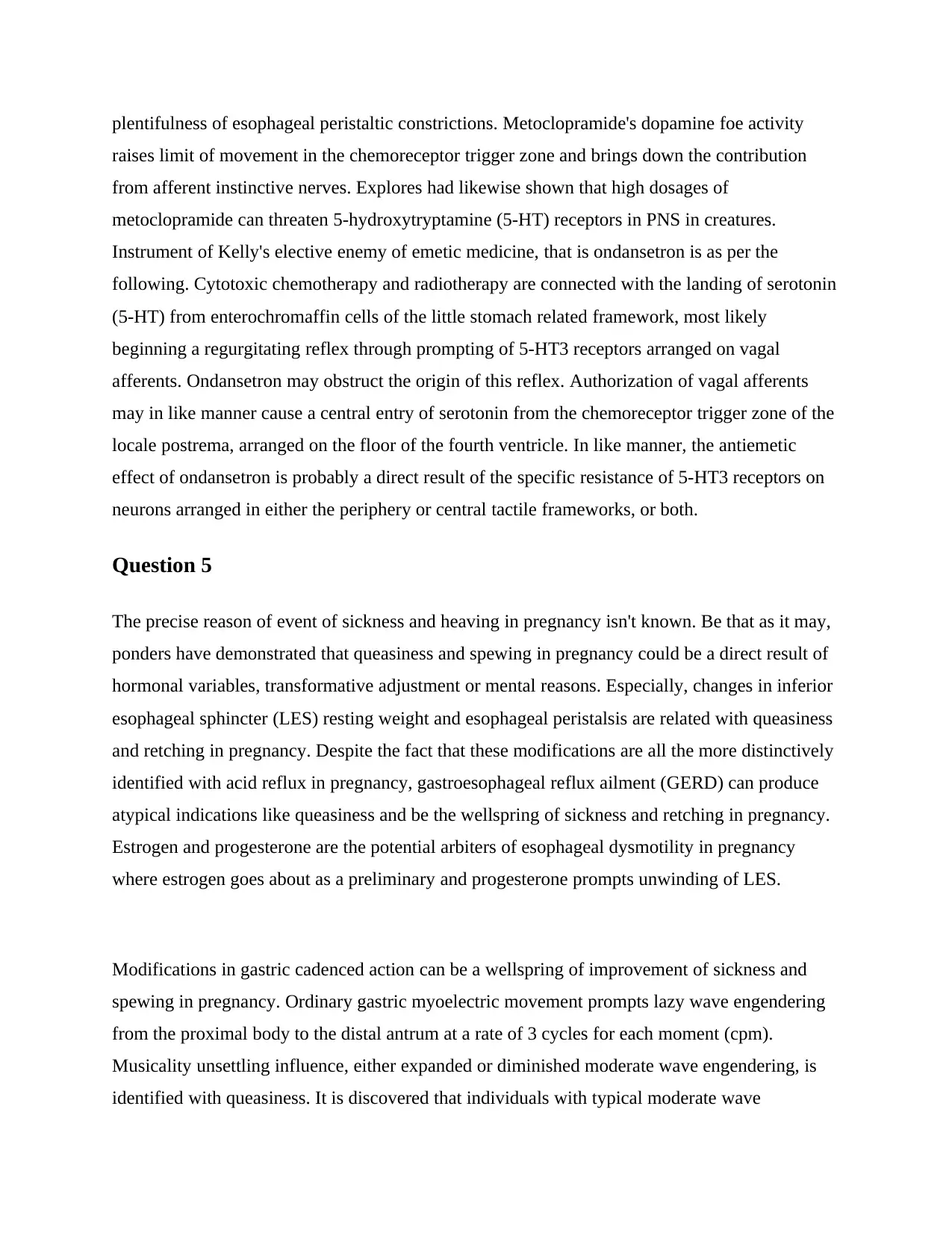
plentifulness of esophageal peristaltic constrictions. Metoclopramide's dopamine foe activity
raises limit of movement in the chemoreceptor trigger zone and brings down the contribution
from afferent instinctive nerves. Explores had likewise shown that high dosages of
metoclopramide can threaten 5-hydroxytryptamine (5-HT) receptors in PNS in creatures.
Instrument of Kelly's elective enemy of emetic medicine, that is ondansetron is as per the
following. Cytotoxic chemotherapy and radiotherapy are connected with the landing of serotonin
(5-HT) from enterochromaffin cells of the little stomach related framework, most likely
beginning a regurgitating reflex through prompting of 5-HT3 receptors arranged on vagal
afferents. Ondansetron may obstruct the origin of this reflex. Authorization of vagal afferents
may in like manner cause a central entry of serotonin from the chemoreceptor trigger zone of the
locale postrema, arranged on the floor of the fourth ventricle. In like manner, the antiemetic
effect of ondansetron is probably a direct result of the specific resistance of 5-HT3 receptors on
neurons arranged in either the periphery or central tactile frameworks, or both.
Question 5
The precise reason of event of sickness and heaving in pregnancy isn't known. Be that as it may,
ponders have demonstrated that queasiness and spewing in pregnancy could be a direct result of
hormonal variables, transformative adjustment or mental reasons. Especially, changes in inferior
esophageal sphincter (LES) resting weight and esophageal peristalsis are related with queasiness
and retching in pregnancy. Despite the fact that these modifications are all the more distinctively
identified with acid reflux in pregnancy, gastroesophageal reflux ailment (GERD) can produce
atypical indications like queasiness and be the wellspring of sickness and retching in pregnancy.
Estrogen and progesterone are the potential arbiters of esophageal dysmotility in pregnancy
where estrogen goes about as a preliminary and progesterone prompts unwinding of LES.
Modifications in gastric cadenced action can be a wellspring of improvement of sickness and
spewing in pregnancy. Ordinary gastric myoelectric movement prompts lazy wave engendering
from the proximal body to the distal antrum at a rate of 3 cycles for each moment (cpm).
Musicality unsettling influence, either expanded or diminished moderate wave engendering, is
identified with queasiness. It is discovered that individuals with typical moderate wave
raises limit of movement in the chemoreceptor trigger zone and brings down the contribution
from afferent instinctive nerves. Explores had likewise shown that high dosages of
metoclopramide can threaten 5-hydroxytryptamine (5-HT) receptors in PNS in creatures.
Instrument of Kelly's elective enemy of emetic medicine, that is ondansetron is as per the
following. Cytotoxic chemotherapy and radiotherapy are connected with the landing of serotonin
(5-HT) from enterochromaffin cells of the little stomach related framework, most likely
beginning a regurgitating reflex through prompting of 5-HT3 receptors arranged on vagal
afferents. Ondansetron may obstruct the origin of this reflex. Authorization of vagal afferents
may in like manner cause a central entry of serotonin from the chemoreceptor trigger zone of the
locale postrema, arranged on the floor of the fourth ventricle. In like manner, the antiemetic
effect of ondansetron is probably a direct result of the specific resistance of 5-HT3 receptors on
neurons arranged in either the periphery or central tactile frameworks, or both.
Question 5
The precise reason of event of sickness and heaving in pregnancy isn't known. Be that as it may,
ponders have demonstrated that queasiness and spewing in pregnancy could be a direct result of
hormonal variables, transformative adjustment or mental reasons. Especially, changes in inferior
esophageal sphincter (LES) resting weight and esophageal peristalsis are related with queasiness
and retching in pregnancy. Despite the fact that these modifications are all the more distinctively
identified with acid reflux in pregnancy, gastroesophageal reflux ailment (GERD) can produce
atypical indications like queasiness and be the wellspring of sickness and retching in pregnancy.
Estrogen and progesterone are the potential arbiters of esophageal dysmotility in pregnancy
where estrogen goes about as a preliminary and progesterone prompts unwinding of LES.
Modifications in gastric cadenced action can be a wellspring of improvement of sickness and
spewing in pregnancy. Ordinary gastric myoelectric movement prompts lazy wave engendering
from the proximal body to the distal antrum at a rate of 3 cycles for each moment (cpm).
Musicality unsettling influence, either expanded or diminished moderate wave engendering, is
identified with queasiness. It is discovered that individuals with typical moderate wave
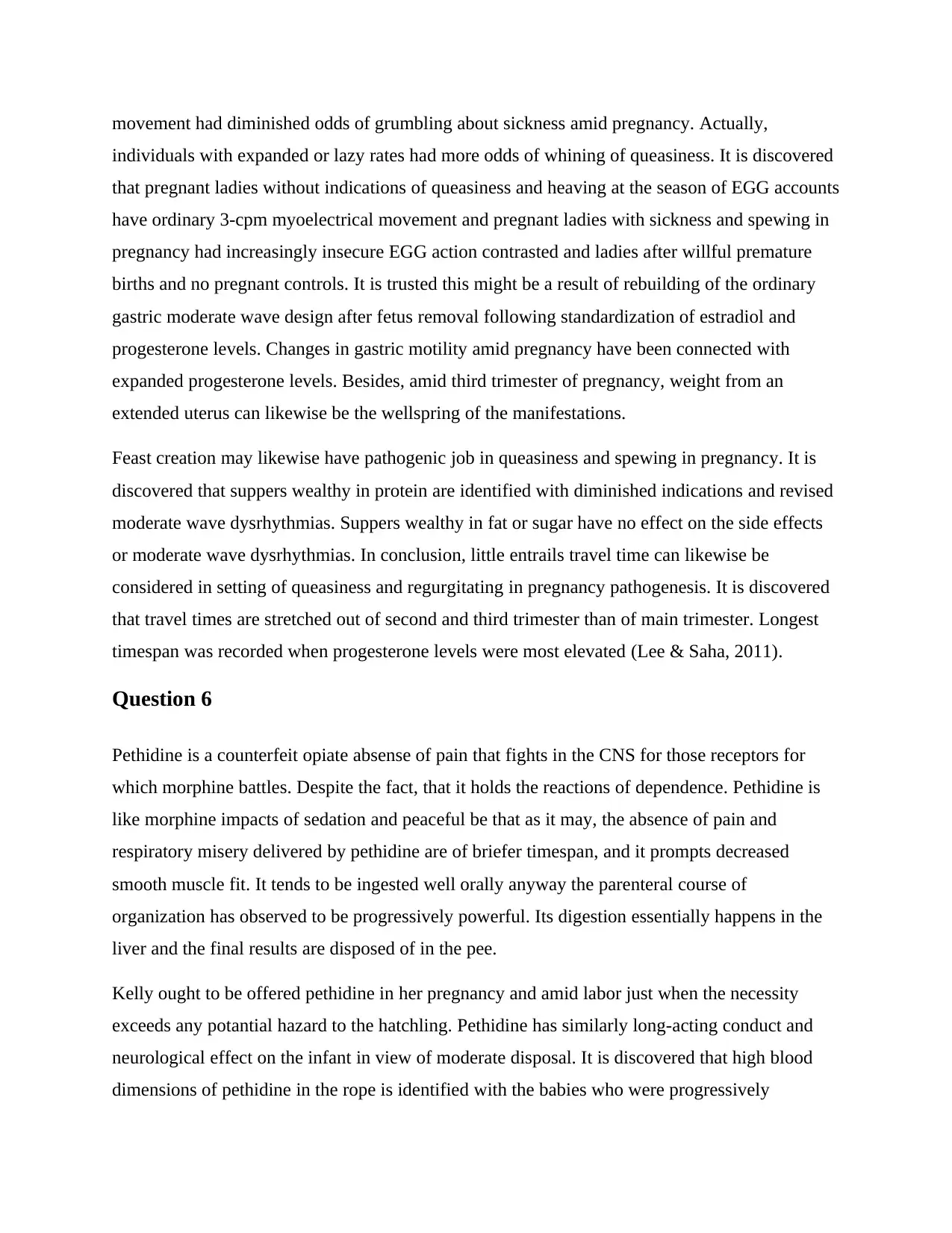
movement had diminished odds of grumbling about sickness amid pregnancy. Actually,
individuals with expanded or lazy rates had more odds of whining of queasiness. It is discovered
that pregnant ladies without indications of queasiness and heaving at the season of EGG accounts
have ordinary 3-cpm myoelectrical movement and pregnant ladies with sickness and spewing in
pregnancy had increasingly insecure EGG action contrasted and ladies after willful premature
births and no pregnant controls. It is trusted this might be a result of rebuilding of the ordinary
gastric moderate wave design after fetus removal following standardization of estradiol and
progesterone levels. Changes in gastric motility amid pregnancy have been connected with
expanded progesterone levels. Besides, amid third trimester of pregnancy, weight from an
extended uterus can likewise be the wellspring of the manifestations.
Feast creation may likewise have pathogenic job in queasiness and spewing in pregnancy. It is
discovered that suppers wealthy in protein are identified with diminished indications and revised
moderate wave dysrhythmias. Suppers wealthy in fat or sugar have no effect on the side effects
or moderate wave dysrhythmias. In conclusion, little entrails travel time can likewise be
considered in setting of queasiness and regurgitating in pregnancy pathogenesis. It is discovered
that travel times are stretched out of second and third trimester than of main trimester. Longest
timespan was recorded when progesterone levels were most elevated (Lee & Saha, 2011).
Question 6
Pethidine is a counterfeit opiate absense of pain that fights in the CNS for those receptors for
which morphine battles. Despite the fact, that it holds the reactions of dependence. Pethidine is
like morphine impacts of sedation and peaceful be that as it may, the absence of pain and
respiratory misery delivered by pethidine are of briefer timespan, and it prompts decreased
smooth muscle fit. It tends to be ingested well orally anyway the parenteral course of
organization has observed to be progressively powerful. Its digestion essentially happens in the
liver and the final results are disposed of in the pee.
Kelly ought to be offered pethidine in her pregnancy and amid labor just when the necessity
exceeds any potantial hazard to the hatchling. Pethidine has similarly long-acting conduct and
neurological effect on the infant in view of moderate disposal. It is discovered that high blood
dimensions of pethidine in the rope is identified with the babies who were progressively
individuals with expanded or lazy rates had more odds of whining of queasiness. It is discovered
that pregnant ladies without indications of queasiness and heaving at the season of EGG accounts
have ordinary 3-cpm myoelectrical movement and pregnant ladies with sickness and spewing in
pregnancy had increasingly insecure EGG action contrasted and ladies after willful premature
births and no pregnant controls. It is trusted this might be a result of rebuilding of the ordinary
gastric moderate wave design after fetus removal following standardization of estradiol and
progesterone levels. Changes in gastric motility amid pregnancy have been connected with
expanded progesterone levels. Besides, amid third trimester of pregnancy, weight from an
extended uterus can likewise be the wellspring of the manifestations.
Feast creation may likewise have pathogenic job in queasiness and spewing in pregnancy. It is
discovered that suppers wealthy in protein are identified with diminished indications and revised
moderate wave dysrhythmias. Suppers wealthy in fat or sugar have no effect on the side effects
or moderate wave dysrhythmias. In conclusion, little entrails travel time can likewise be
considered in setting of queasiness and regurgitating in pregnancy pathogenesis. It is discovered
that travel times are stretched out of second and third trimester than of main trimester. Longest
timespan was recorded when progesterone levels were most elevated (Lee & Saha, 2011).
Question 6
Pethidine is a counterfeit opiate absense of pain that fights in the CNS for those receptors for
which morphine battles. Despite the fact, that it holds the reactions of dependence. Pethidine is
like morphine impacts of sedation and peaceful be that as it may, the absence of pain and
respiratory misery delivered by pethidine are of briefer timespan, and it prompts decreased
smooth muscle fit. It tends to be ingested well orally anyway the parenteral course of
organization has observed to be progressively powerful. Its digestion essentially happens in the
liver and the final results are disposed of in the pee.
Kelly ought to be offered pethidine in her pregnancy and amid labor just when the necessity
exceeds any potantial hazard to the hatchling. Pethidine has similarly long-acting conduct and
neurological effect on the infant in view of moderate disposal. It is discovered that high blood
dimensions of pethidine in the rope is identified with the babies who were progressively
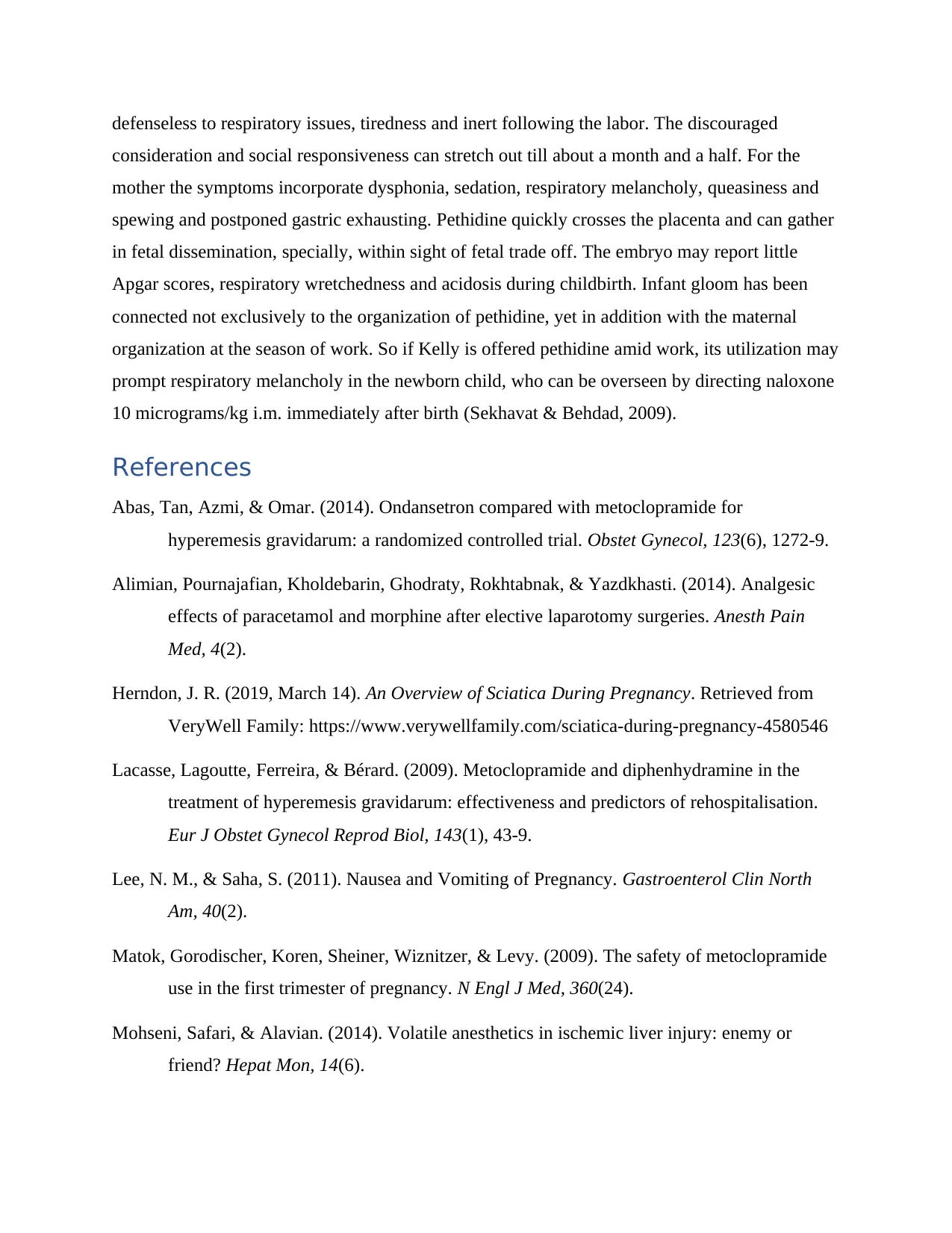
defenseless to respiratory issues, tiredness and inert following the labor. The discouraged
consideration and social responsiveness can stretch out till about a month and a half. For the
mother the symptoms incorporate dysphonia, sedation, respiratory melancholy, queasiness and
spewing and postponed gastric exhausting. Pethidine quickly crosses the placenta and can gather
in fetal dissemination, specially, within sight of fetal trade off. The embryo may report little
Apgar scores, respiratory wretchedness and acidosis during childbirth. Infant gloom has been
connected not exclusively to the organization of pethidine, yet in addition with the maternal
organization at the season of work. So if Kelly is offered pethidine amid work, its utilization may
prompt respiratory melancholy in the newborn child, who can be overseen by directing naloxone
10 micrograms/kg i.m. immediately after birth (Sekhavat & Behdad, 2009).
References
Abas, Tan, Azmi, & Omar. (2014). Ondansetron compared with metoclopramide for
hyperemesis gravidarum: a randomized controlled trial. Obstet Gynecol, 123(6), 1272-9.
Alimian, Pournajafian, Kholdebarin, Ghodraty, Rokhtabnak, & Yazdkhasti. (2014). Analgesic
effects of paracetamol and morphine after elective laparotomy surgeries. Anesth Pain
Med, 4(2).
Herndon, J. R. (2019, March 14). An Overview of Sciatica During Pregnancy. Retrieved from
VeryWell Family: https://www.verywellfamily.com/sciatica-during-pregnancy-4580546
Lacasse, Lagoutte, Ferreira, & Bérard. (2009). Metoclopramide and diphenhydramine in the
treatment of hyperemesis gravidarum: effectiveness and predictors of rehospitalisation.
Eur J Obstet Gynecol Reprod Biol, 143(1), 43-9.
Lee, N. M., & Saha, S. (2011). Nausea and Vomiting of Pregnancy. Gastroenterol Clin North
Am, 40(2).
Matok, Gorodischer, Koren, Sheiner, Wiznitzer, & Levy. (2009). The safety of metoclopramide
use in the first trimester of pregnancy. N Engl J Med, 360(24).
Mohseni, Safari, & Alavian. (2014). Volatile anesthetics in ischemic liver injury: enemy or
friend? Hepat Mon, 14(6).
consideration and social responsiveness can stretch out till about a month and a half. For the
mother the symptoms incorporate dysphonia, sedation, respiratory melancholy, queasiness and
spewing and postponed gastric exhausting. Pethidine quickly crosses the placenta and can gather
in fetal dissemination, specially, within sight of fetal trade off. The embryo may report little
Apgar scores, respiratory wretchedness and acidosis during childbirth. Infant gloom has been
connected not exclusively to the organization of pethidine, yet in addition with the maternal
organization at the season of work. So if Kelly is offered pethidine amid work, its utilization may
prompt respiratory melancholy in the newborn child, who can be overseen by directing naloxone
10 micrograms/kg i.m. immediately after birth (Sekhavat & Behdad, 2009).
References
Abas, Tan, Azmi, & Omar. (2014). Ondansetron compared with metoclopramide for
hyperemesis gravidarum: a randomized controlled trial. Obstet Gynecol, 123(6), 1272-9.
Alimian, Pournajafian, Kholdebarin, Ghodraty, Rokhtabnak, & Yazdkhasti. (2014). Analgesic
effects of paracetamol and morphine after elective laparotomy surgeries. Anesth Pain
Med, 4(2).
Herndon, J. R. (2019, March 14). An Overview of Sciatica During Pregnancy. Retrieved from
VeryWell Family: https://www.verywellfamily.com/sciatica-during-pregnancy-4580546
Lacasse, Lagoutte, Ferreira, & Bérard. (2009). Metoclopramide and diphenhydramine in the
treatment of hyperemesis gravidarum: effectiveness and predictors of rehospitalisation.
Eur J Obstet Gynecol Reprod Biol, 143(1), 43-9.
Lee, N. M., & Saha, S. (2011). Nausea and Vomiting of Pregnancy. Gastroenterol Clin North
Am, 40(2).
Matok, Gorodischer, Koren, Sheiner, Wiznitzer, & Levy. (2009). The safety of metoclopramide
use in the first trimester of pregnancy. N Engl J Med, 360(24).
Mohseni, Safari, & Alavian. (2014). Volatile anesthetics in ischemic liver injury: enemy or
friend? Hepat Mon, 14(6).
Paraphrase This Document
Need a fresh take? Get an instant paraphrase of this document with our AI Paraphraser
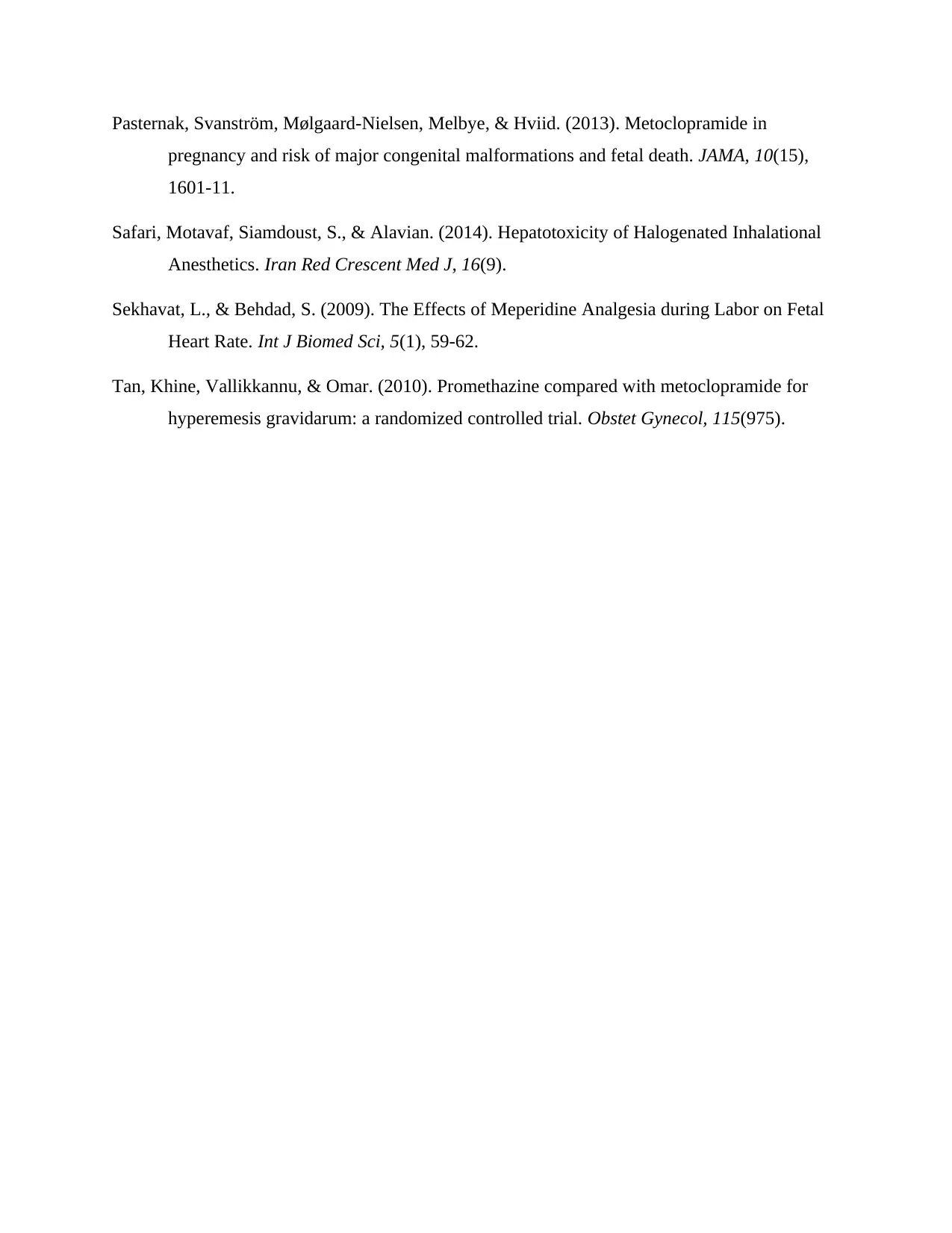
Pasternak, Svanström, Mølgaard-Nielsen, Melbye, & Hviid. (2013). Metoclopramide in
pregnancy and risk of major congenital malformations and fetal death. JAMA, 10(15),
1601-11.
Safari, Motavaf, Siamdoust, S., & Alavian. (2014). Hepatotoxicity of Halogenated Inhalational
Anesthetics. Iran Red Crescent Med J, 16(9).
Sekhavat, L., & Behdad, S. (2009). The Effects of Meperidine Analgesia during Labor on Fetal
Heart Rate. Int J Biomed Sci, 5(1), 59-62.
Tan, Khine, Vallikkannu, & Omar. (2010). Promethazine compared with metoclopramide for
hyperemesis gravidarum: a randomized controlled trial. Obstet Gynecol, 115(975).
pregnancy and risk of major congenital malformations and fetal death. JAMA, 10(15),
1601-11.
Safari, Motavaf, Siamdoust, S., & Alavian. (2014). Hepatotoxicity of Halogenated Inhalational
Anesthetics. Iran Red Crescent Med J, 16(9).
Sekhavat, L., & Behdad, S. (2009). The Effects of Meperidine Analgesia during Labor on Fetal
Heart Rate. Int J Biomed Sci, 5(1), 59-62.
Tan, Khine, Vallikkannu, & Omar. (2010). Promethazine compared with metoclopramide for
hyperemesis gravidarum: a randomized controlled trial. Obstet Gynecol, 115(975).
1 out of 8
Your All-in-One AI-Powered Toolkit for Academic Success.
+13062052269
info@desklib.com
Available 24*7 on WhatsApp / Email
![[object Object]](/_next/static/media/star-bottom.7253800d.svg)
Unlock your academic potential
© 2024 | Zucol Services PVT LTD | All rights reserved.

